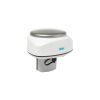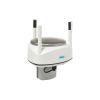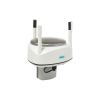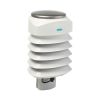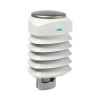Vaisala WXT536 Multi-Parameter Weather Sensor
Features
- Low power consumption is ideal for battery powered systems
- No moving parts for durability and long maintenance intervals
- Easy integration with 3rd party data collection platforms
- Free ground shipping
- Expedited repair and warranty service
- Lifetime technical support
- More
Flexibility
The Vaisala WXT536 is a multi-parameter weather sensor that simultaneously measures air temperature, humidity, pressure, rainfall and wind in a compact platform with optional heating. Low power consumption enables solar panel applications. The Vaisala WXT530 Series focuses on maintenance-free operations in a cost-effective manner.
Integration
The series offers analog input options for additional third-party analog sensors. With the help of the built-in analog to digital converters, the Weather Transmitter WXT530 turns into a small, cost-effective weather parameter hub. Additional parameters include the solar radiation and external temperature sensor. Further, the analog mA output option for wind speed and direction enables a wide variety of industrial applications. The WXT530 exceeds IEC60945 maritime standard.
Solid Performance
The WXT530 Series has a unique Vaisala solid state sensor technology. To measure wind, the ultrasonic Vaisala WINDCAP Sensors are applied to determine horizontal wind speed and direction. Barometric pressure, temperature, and humidity measurements are combined in the PTU module using capacitive measurement for each parameter. This module is easy to change without contacting the sensors. The precipitation measurement is based on the unique acoustic Vaisala RAINCAP Sensor without flooding, clogging, wetting, and evaporation losses.
In The News
Combining Academia and Lake Associations: Monitoring Lake Lillinonah
Lake Lillinonah may be Connecticut's second-largest lake, but it holds a great deal of meaning for locals and researchers in the surrounding towns. The lake is so significant to the surrounding community that it is one of many lakes in the United States with a dedicated lake association advocating for the resource. Jen Klug, Professor of Biology in the College of Arts and Sciences at Fairfield University , started her career at Fairfield as a natural progression in her background as a classical aquatic ecologist and found herself working closely with Lake Lillinonah's Friends of the Lake (FOTL) when they reached out to collaborate on an algae presentation for a public forum back in 2006.
Read MoreRebuilding Trust in Science and Protecting Resources: Thomas More University Biology Field Station
Many universities and environmental organizations have field stations where monitoring equipment is deployed, and various environmental restoration initiatives are conducted. One example is the Thomas More University Biology Field Station . The Field Station is managed by a team of students, faculty, and staff who facilitate ongoing restoration and monitoring programs. Molly Williams is the Station Manager of the facility and spends her days overseeing various research projects, internships, and outreach initiatives. Having been an intern with the Field Station in 2021, Williams was excited to return as the Field Station Manager in 2023. Williams' initial time at the Field Station as an intern confirmed her decision to switch from a pre-med track to the field of ecology.
Read MoreSustainable Data Collection: Climate Monitoring in the Caribbean
Environmental monitoring in the Caribbean may be essential, but it has also historically been placed on the back burner. Albert Jones, Instrumentation Officer for the Caribbean Community Climate Change Centre (CCCCC), explains, “Data collection itself is not what is considered one of those sexy activities where you can easily get funding.” Still, monitoring the water surrounding island nations is necessary to protect residents and the environment. The CCCCC works to establish environmental monitoring networks and systems in the Caribbean. One aspect of Jones’ work centers around data buoy instrumentation and deployment,—equipment that will be used to support Ecoforecasts for Coral Health Monitoring and to provide valuable environmental data to the public.
Read More














